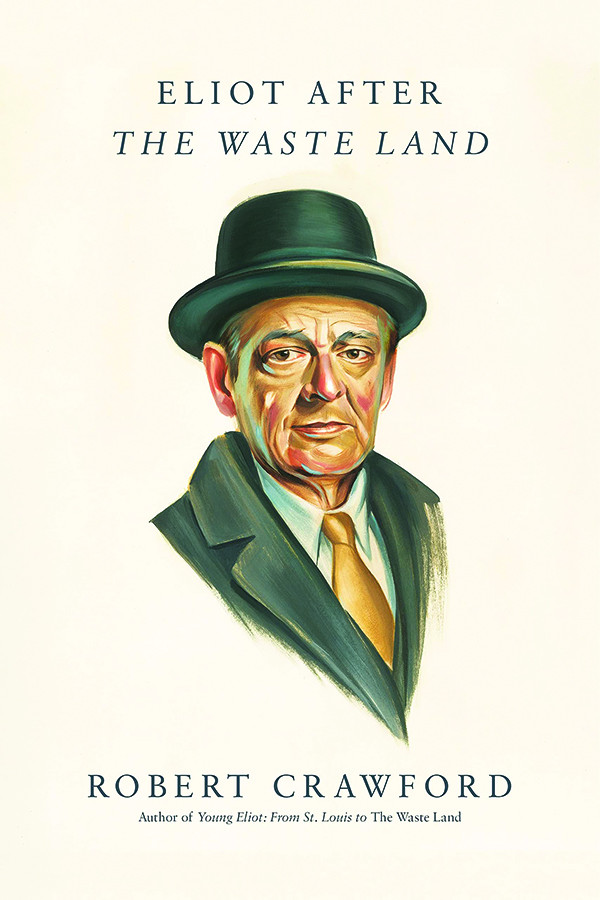When Virginia Woolf called Thomas Stearns Eliot an “unhappy man wrapt up in fibres of self-torture, doubt, and conceit,” she may have suspected that he would ruin several women’s lives.

Arguably, one of them was Vivien Haigh-Wood Eliot, the poet’s first wife, whom he abandoned and later had committed to a mental hospital. Vivien was an emotionally frail woman Eliot married in haste. Ezra Pound, who had helped Eliot launch his writing career, pushed him to marry Vivien as a way to keep him in England.
In this biography of T.S. Eliot, Robert Crawford includes the women closest to him: Charlotte Eliot, his mother who wrote poetry and sang “The Little Tailor” to him as a baby; Ada Eliot, his sister who was 19 when he was born; Emily Hale, an American actress and his first love; Vivien Eliot; Mary Trevelyan, his longtime confidante and best friend; and Valerie Fletcher, his second wife who cared for him when he was dying of emphysema.
These women were grist for his poetic mill. He was also inspired by his adopted country, England, and its religion. He dropped his American citizenship and converted from Unitarianism to Anglo-Catholicism. He considered joining a monastery and living a life of prayer in the desert.
Ten years after Vivien died, he married his secretary, Valerie Fletcher. She was 38 years younger than he.
By then, most of his creative ability was spent. He stopped writing poetry in 1943 with Four Quartets, and his final play, The Elder Statesman, received mostly negative reviews in 1958. Ironically, one reason he gave for not marrying Emily Hale was that she would kill the poet in him.
Crawford’s book can be slow going as it meticulously examines the public, private, and spiritual sides of the complex man the members of the Swedish Academy called the greatest influence on the literary world in the 20th century. During the 1948 Nobel Prize ceremony, they especially praised Eliot’s 1922 poem, “The Waste Land,” with its scathing criticism of the confusion and vulgarity of the post-World War I years.
A renowned poet, dramatist, critic, publisher, and editor, Eliot accepted the prize with uncharacteristic modesty, saying that he received the award not on his own merits but “as a symbol … of the significance of poetry.” He believed the “supra-national value of poetry” ignited the creative imagination and helped people to connect with different cultures. Connection is the underlying subject of much of his work, including “The Waste Land,” which celebrates its 100th birthday in 2022.
Eliot’s poems tend to be dense, erudite, and collagelike. “The Waste Land,” edited by Ezra Pound, is no exception. According to Crawford, Pound’s removal of several sections of this long poem made it slightly more accessible. Its theme is suggestive of the emotional turmoil following the war as well as the futility of living in a godless world without shared religious values. Its meaning emerges as the parts of the work come together. Despite its difficulties, this poem is seen as one of the greatest modernist works of the 20th century.
This second volume of Crawford’s definitive biography references his 2015 book, Young Eliot from St. Louis to “The Waste Land,” which covers Eliot’s birth, family, and formative years in St. Louis, Missouri, as well as his summers spent in Gloucester, Massachusetts. He was a shy, sexually awkward boy with big ears, and he liked to read. As the youngest of six siblings, he was ordered about by his four sisters and his older brother, Henry. After Eliot graduated from Harvard, he studied philosophy. Then in 1914, he went to Oxford to continue his graduate studies in philosophy.
Eliot After “The Waste Land” begins with him living in London, married to Vivien, and working at Lloyd’s bank. We learn of Eliot’s job as director at Faber and Faber, where he connected with literary celebrities such as William Carlos Williams, Marianne Moore, E.E. Cummings, Robert Lowell, Virginia Woolf, and Ezra Pound. There is also his time as editor of The Criterion, his work as a fire watcher during the Blitz, and his December/May marriage.
Crawford covers numerous situations that Eliot would want to keep private, including the times he was spotted on the streets of London wearing greenish face powder and using lipstick. He also tried to suppress his letters to Emily Hale, which were released from the Princeton University Library in January 2020 after a 50-year embargo. Eliot renounced Emily in a note that accompanied the letters.
The poem most inspired by Emily was “Four Quartets,” the poem Eliot considered his best. He wrote “Old Possum’s Book of Practical Cats” for his godchildren. “Murder in the Cathedral” was written out of the religious feelings that accompanied his conversion to Anglo-Catholicism. Crawford references several of Eliot’s essays, such as “After Strange Gods,” which Eliot disliked in later years because it suggested he was prejudiced toward black and Jewish people.
Eliot had insisted that no one write his biography and burned letters, even from his family, to keep his affairs private. It amazed Eliot that people could write an autobiography. As he put it, “It is probably because they have less to suppress than I have.” All of which give this biography an ironic quality. Readers may feel as if they’re trespassing but won’t want to put the book down since it is fascinating to see Eliot’s life mirrored in his poems.
Ultimately, Crawford builds an in-depth portrait of Eliot, warts and all, as he combs through almost every detail of Eliot’s surviving papers, including more than 2,000 pages of poetry, 7,000 pages of prose, and 10,000 pages of other documents. Saying he wants to avoid moralizing, he lets the facts speak for themselves, and, in this compelling biography, they do.
Diane Scharper is a writer and editor. She teaches memoir and poetry for the Johns Hopkins University Osher Program.

